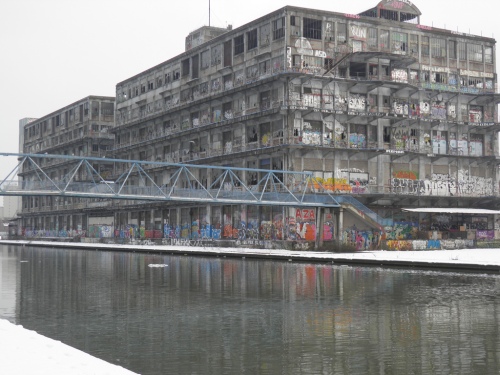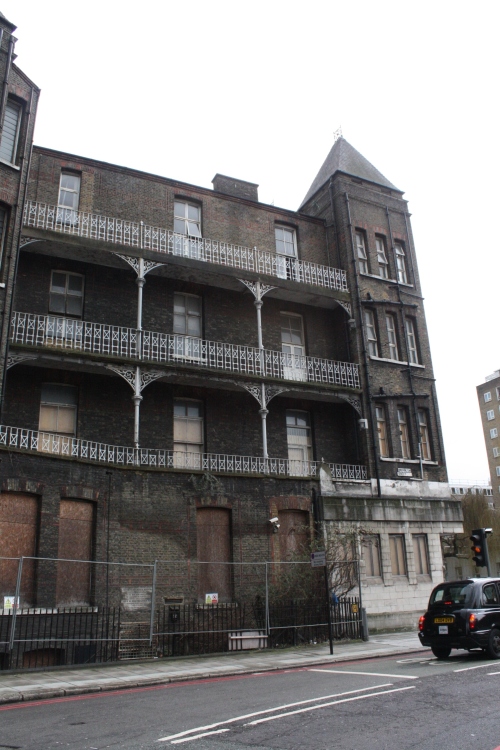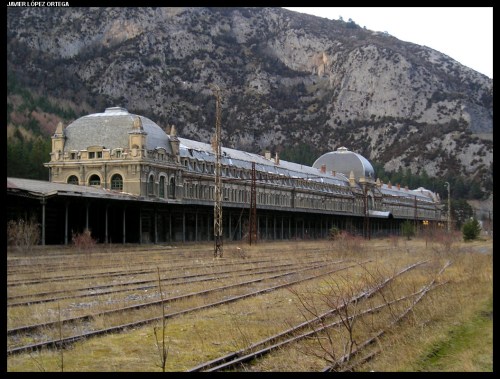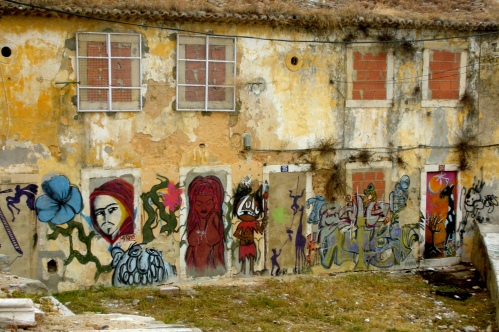|
||||||||||||||||
|
|
||||||||||||||||
|
Posted in Uncategorized
|
||||||||||||||||
|
Posted in Uncategorized
Hi guys,
we are very happy to announce that we moved to www.impossibleliving.com with a lot of cool new features!!
Meet you there!!
Bye,
Andrea & Daniela
Posted in Uncategorized
 by simon.berthiau, a view of an abandoned warehouse along the Ourque channel
by simon.berthiau, a view of an abandoned warehouse along the Ourque channelupdated check out the youtube “93 pantin” video exploring the inside of the building and the new updates about the future of the building (below)!!
The construction of this enormous building, located on the south side of Pantin harbor, was part of a great project to transform Ourcq channel into an important navigable vector and to connect it to French bigger rivers. The project, started at the beginning of the last century, included also the implementation of the Pantin harbor and the enlargement of the Ourcq channel.
The building, the Chambre de Commerce et d’Industrie de Paris (CCIP) deposit, was ended between 1929 and 1931 and it is composed of two warehouses, at the time dedicated to the storage and supply of grains and flour shipped by boat through the Ourcq channel to the city of Paris. The building also served as customs office.
Unfortunately it’s difficult to find information about this place and we weren’t able to discover when the building was dismissed and what happened later until now. It appears it is (or has been) a squat, but we couldn’t find any other confirm about that.
There is an interest for the building and, in general, for all the Ourcq industrial structures that must be converted, as they are no longer used. It seems someone has already designed a renovation solution for this amazing place, but not much information are provided!
The industrial age is over and the reconquest of the canal banks is on the agenda. The CCIP deposit renovation now is part of a bigger project, consisting in the achievement of a new district, identified in the local plan as the BIA South Canal. The twin buildings of the former Chamber of Commerce and Industry of Paris will be rehabilitated to accommodate economic activities. On the southern site, a residential space (400 units), recreation and walking should be developed. If we consider the old administrative city, become the National Centre of Dance, and the Grands Moulins de Pantin, the conversion of the CCIP site will be a coherent continuation of the problematic heritage of industrial architecture, started from the park of La Villette.
Sources (in french):
– atlas-patrimoine93
– technical documentation – pdf, from page 63 to 70)
– tourisme93
 by lostlosangeles, a view of Tresure Island in the Oakland-San Francisco Bay
by lostlosangeles, a view of Tresure Island in the Oakland-San Francisco BayTreasure Island sits in the middle of the Oakland-San Francisco Bay Bridge and exemplifies the rapid cycling of American progress and dereliction.
This artificial island was first created as part of the Golden Gate International Expo in 1936 and 1937, planned for and used as an airport for Pan American World Airways flying boats. During WWII it became part of the Treasure Island Naval Base and mainly served as an electronics and communication training school for WWII.
In the recent years the navy base was closed and now the island belongs to the City and County of San Francisco. A development project has been approved to convert the island in a self-sustaining area and now waits to be realized, even though the actual plan was delayed and first activities are expected by 2012.
In the meanwhile Tresure Island sits as a half abandoned testament to wartime construction. These boarded up buildings serve as reminders.
for further readings Wikipedia
 by quite peculiar, a view of Temperance Hospital in London
by quite peculiar, a view of Temperance Hospital in LondonThose of you who ride the 29, along with some other buses that go up Hampstead Road, should be familiar with this abandoned building. It’s the London Temperance Hospital, renamed the National Temperance Hospital, currently sitting empty and abandoned next to the Robert Street bus stop, which was formerly the National Temperance Hospital stop.

Here’s what wikipedia has to say about it:
The National Temperance Hospital (London Temperance Hospital before 1939) is an abandoned hospital in Hampstead Road, London, near Camden Town. It opened on 6th October 1873 by initiative of the National Temperance League, and was managed by a board of 12 teetotallers. Under its rules, the use of alcohol to treat patients was discouraged, but not outlawed: doctors could prescribe alcohol when they thought necessary for exceptional cases.
In 1931, Chicago magnate Samuel Insull donated $160 000 to build a new extension, the “Insull Memorial wing”.
It was incorporated into the National Health Service in 1948 and eventually came under the management of University College Hospital.
It was closed and disaffected in 1990. In recent years the site has been considered for redevelopment or refurbishment into the new center for the National Institute for Medical Research. Currently (as of 2010) the original building is still standing, boarded-up.
 by Javier Lopez, view of Canfranc International Station
by Javier Lopez, view of Canfranc International StationCanfranc International station is located in Aragon, close to the Franco-Spanish border in the province of Huesca. It is the second largest station in Europe by the size of its facilities. Built with the intention of a great future, nowadays is dedicated to local traffic on the Spanish side and it is probably the biggest railway waste of the world.
The intention to build a railway between Spain and France, through the Pyrenees, was manifested around the half of the 19th century. The project once started, was interrupted many times, because of political disputes between the two countries and because of its environmental impact, until in 1907 a location was finally chosen: Canfranc.
Designed by the architect Fernando Ramirez de Dampierre, the station was meant to embody the importance of a great international project and the Spanish openness to Europe. Inaugurating it the 18th July of 1928, Alfonso XIII in his speech said “The Pyrenees do not exist anymore”, stressing the strategic importance of the railway project and magnifying its station, Canfranc.
All this importance vanished just a few years later, when it became clear that the railway was not so strategic as it appeared to its inspirers.
Canfranc partially recovered during WWII because of its international status and its geographical position. Hundreds of Jews, resistance fighters, Allied airmen, as well as Nazists crossed this small city during this period (the Nazists, in particular used the station to transport the gold sent to general Franco, in return of the strategic minerals banned by the Allies they received from him, see Pascal Desmichelle’s site).
Closed during the last years of the war, the railway line reopened in 1948 with no success and not enough interest. An accident happened on 27th March 1970 was the perfect pretext for the closure of the international line, and since then Canfranc has been crossed only by local traffic.
After three decades of decline and abandonment, the site continue to attract tourists for its historical and landscape importance. Many projects have been discussed through the years for the station’s restoration, but the huge investment necessary and long debates about the possible new destinations of the facility have slowed the process. Recently some intervention has been made for its restoration, and we hope soon to tell you more about the future of such a wonderful place, where I guess it’s definitely possible to benefit investing in its rescue!!
Webography:
– The Canfranc Project by Matthias Maas and Stefan Gregor;
– Canfranc on wikipedia;
– Canfranc railway station by Forbidden Places
– Pascal Desmichelle , “The monumental station Canfranc the test of time. Rise and Fall of a railway heritage of the mountain Aragon (Spain)”.
 by Arianna Neri, view of an abandoned area hidden among the streets of Lisbon
by Arianna Neri, view of an abandoned area hidden among the streets of LisbonThis completely abandoned area is hidden among the winding narrow streets of Lisbon. I recall it being in the surroundings of Castle Sao Jorge, on the highest hill of the city (here the exact location). The area comprises the remainings of what seems to be a residential area and is now house of cats, street artists and piles of garbage.
 by Arianna Neri, another view of the abandoned area in Lisbon
by Arianna Neri, another view of the abandoned area in Lisbon
 by Arianna Neri, industrial complex partially abandoned in Battersea, London
by Arianna Neri, industrial complex partially abandoned in Battersea, LondonThis amazing industrial complex is located in Battersea, just behind the Thames and in front of the headquarters of one of the most important architectural agencies in the world, Foster & Partners. Its interesting structure and nature allow it to be house of some design studios, former night club, space for parties and, at the same time, partially abandoned.
 by Andrea Sesta, an abandoned parking downtown Milan, a few blocks from Duomo
by Andrea Sesta, an abandoned parking downtown Milan, a few blocks from DuomoThis place is incredible: we’re in via Rovello right next to via Dante, in the very center of Milan. The parking is right in front of the Algerian Consulate, but seems abandoned by many years.
 by Andrea Sesta, an internal view of the abandoned parking
by Andrea Sesta, an internal view of the abandoned parkingInside the place everything is in ruin: on the right side there is an office (probably where customers used to pay before leaving), on the left side a door to another internal space (from the outside it was impossible to understand what kind, may be a repair area) and on the bottom a small building.
 by Andrea Sesta, another internal view of the abandoned parking
by Andrea Sesta, another internal view of the abandoned parkingDoes anybody know anything about this place? Contact us!!